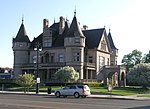Charles Lang Freer House
Culture of DetroitGilded Age mansionsHistoric district contributing properties in MichiganHouses completed in 1887Houses in Detroit ... and 7 more
Houses on the National Register of Historic Places in MichiganMichigan State Historic SitesNRHP infobox with nocatNational Register of Historic Places in DetroitShingle Style architecture in MichiganShingle Style housesUse mdy dates from August 2023

The Charles Lang Freer House is located at 71 East Ferry Avenue in Detroit, Michigan, USA. The house was originally built for the industrialist and art collector Charles Lang Freer, whose gift of the Freer Gallery of Art began the Smithsonian Institution in Washington, DC. The structure currently hosts the Merrill Palmer Skillman Institute of Child & Family Development of Wayne State University. It was designated a Michigan State Historic Site in 1970 and listed on the National Register of Historic Places in 1971.
Excerpt from the Wikipedia article Charles Lang Freer House (License: CC BY-SA 3.0, Authors, Images).Charles Lang Freer House
East Ferry Avenue, Detroit Midtown
Geographical coordinates (GPS) Address Nearby Places Show on map
Geographical coordinates (GPS)
| Latitude | Longitude |
|---|---|
| N 42.361944444444 ° | E -83.065833333333 ° |
Address
Pauline Knapp Building
East Ferry Avenue 87
48202 Detroit, Midtown
Michigan, United States
Open on Google Maps






